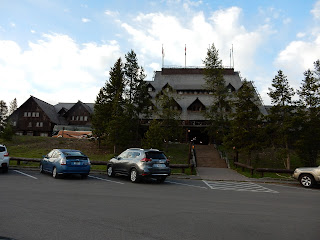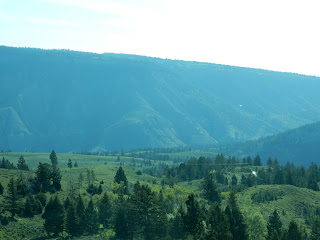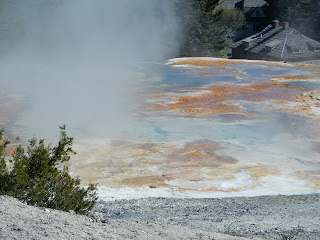We were up early and left the hotel at 6:40 am. Before leaving, we had to scrape frost from the windows of the car. Can't say we've ever done that the end of May! The temperature was 35*. Yesterday we were able to cover the area from the east entrance of Yellowstone to Fishing Bridge and Lake Village and then north through Canyon Village to Tower-Roosevelt. Then we backtracked to Canyon Village and took the road to Norris Geyser Basin. We didn't make any stops since this area was on our list for today. First though, here are some pictures of our hotel, Old Faithful Inn.
First, a view from 1920
A view from 2013
Old Faithful Inn 2017
Old Faithful Inn 2017
These are some pictures of the lobby area and the front porch.
Front porch
The clock above the fireplace in the lobby
This clock shows the next predicted
eruption of Old Faithful
All of the interior looked like this
So, off we go! It was a beautiful, sunny day. At times the sun worked against us for pictures but we did the best we could. First we saw lots of steam vents in the Upper Geyser Basin. Steam vents are hot springs without enough water to erupt or overflow. The small amount of water boils away, leaving only steam and other gases to escape. Also called fumaroles, steam vents usually exist on higher ground above other geothermal features.
The Upper Geyser Basin area contains the world's largest concentration of geysers, including the star of the show, Old Faithful. Boardwalks and paved trails allow visitors to walk within safe distance of geysers, fumaroles, hot springs and mud pots across the basin. Yellowstone, as a whole, possesses close to 60% of the world's geysers. Within one square mile of the Upper Geyser Basin, there are at least 150 of these hydrothermal wonders. Of this remarkable number, only 5 major geysers are predicted regularly by the naturalist staff.
Steam vents in the Upper Geyser Basin
Steam vents in the Upper Geyser Basin
Next stop was Gibbon Falls. Here the water tumbles 84' over the cliff's edge.
Gibbon Falls
Gibbon Falls
The Gibbon River below Gibbon Falls
The next stop was at Twin Lakes. WOW! The reflection was gorgeous!
South Twin Lake
South Twin Lake
North Twin Lake
Slow moving traffic near Indian Creek
Gallatin Range near Indian Creek
Gallatin Range near Indian Creek
The next two pictures are from the Golden Gate area. It was almost impossible to get a good picture of the golden walls. The Golden Gate is named after the light-colored welded rock formed from cool lava flows.
This picture of the Golden Gate bridge is from
Wikipedia. Mine from this point didn't turn out
as bright.
Golden Gate area
Near Mammoth Hot Springs
The springs at Mammoth Hot Springs are characterized by terrace-like formations created by limestone deposits. In the Mammoth area, the hot, acidic solution dissolves large quantities of limestone on its way up through the rock layers to the hot springs on the surface. Above ground and exposed to the air, some of the carbon dioxide escapes from the solution. Without it, the dissolved limestone can't remain in the solution, so it reforms into a solid mineral. This white, chalky mineral is deposited as the travertine that forms the terraces. There are about 50 springs in this area.
Terraces at Mammoth Hot Springs
Terraces at Mammoth Hot Springs
Terraces at Mammoth Hot Springs
Terraces at Mammoth Hot Springs
Terraces at Mammoth Hot Springs
Terraces at Mammoth Hot Springs
Terraces at Mammoth Hot Springs
Cleopatra Terrace
Palette Spring
Palette Spring
Liberty Cap at Palette Spring
Fort Yellowstone was next on the list. It was a US Army fort, established in 1891. It is now the Yellowstone National Park headquarters. Between the years 1891 and 1913, a total of 60 structures were erected, of which 35 were still in existence 100 years later.
Fort Yellowstone
Fort Yellowstone
Fort Yellowstone
Fort Yellowstone
Fort Yellowstone - look closely and you can see
ladders leading up to 2nd floor windows to be
used as a fire escape.
Fort Yellowstone
It was lunch time by the time we left here. We headed towards the north entrance of the park to Gardiner, Montana. The town was small and being Memorial Day and the season hadn't really begun, we had trouble finding a place to eat. We went to one place and they told us to be seated and someone would wait on us. Well, that didn't happen so after about 15 or 20 minutes we left. The next place, Rosie's Bistro, we were asked if we wanted the breakfast menu or lunch menu. The waiter gave us the lunch menu but said they wouldn't be serving it for another 10 minutes or so and the waitress would be there shortly and he walked off. Well, after almost 30 minutes, she showed up. The service was terrible and the original guy who waited on us would never come back - he just kind of disappeared. We were pretty frustrated when we left there but we were full and ready to move on.
The Roosevelt Arch exiting the north entrance of the park
Roosevelt Arch - north entrance of Yellowstone
The road in the park follows the Gardiner River. Being there in spring, the river was really raging in places.
The Gardiner River
The Gardiner River
Another beautiful view!
The 45th
parallel is between Mammoth and Gardiner.
It’s the halfway point between the equator and the North Pole.
Canary Spring
Grassy Spring bubbles above the boardwalk and spills down a surface of rippled orange travertine deposits. Thermophiles, microorganisms that love heat, are responsible for the rich color of Grassy Spring and other hydrothermal features in Yellowstone Yellow marks extremely hot water while greens and blues typically mark pools cooler than 140*.
Grassy Spring
The Sheepeater Cliffs are a series of exposed cliffs made up of columnar basalt. The lava was deposited about 500,000 years ago during one of the periodic basaltic floods in Yellowstone Caldera, and later exposed by the Gardner River. The cliffs are noted as a textbook example of a basaltic flow with well defined joints and hexagonal columns.
Sheepeater Cliff
Sheepeater Cliff
Norris Geyser Basin was the next stop. It has a boardwalk and trails that lead across the barren valley of steam vents and rainbow-colored pools. This is the oldest and hottest geothermal area in the park with water temperatures above 200*. Norris sits on the intersection of three major faults. These faults are the primary reason that Norris Geyser Basin is so hot and dynamic.
Norris Geyser Basin
Norris Geyser Basin
Norris Geyser Basin
Norris Geyser Basin
Norris Geyser Basin
Norris Geyser Basin
Norris Geyser Basin
Norris Geyser Basin
Near Norris Geyser Basin
Next we explored the Fountain Paint Pot area. This is in the Lower Geyser Basin which is on unstable glacial sediments atop solid rock. The jarring energy of an earthquake can make the gravel vibrate and shift position, and compact or fracture the basin. All these changes affect water supplies to hot springs. They might force muddy water to the surface, clouding existing pools or creating new ones. They might divert water from a pool, causing it to dry up. Water temperatures might also increase or decrease due to these subsurface changes. These boiling pools of red,
yellow and brown mud change with the seasons and the water table. They earned
their name from the colors produced by the mud’s high acidity levels. The mud is composed of clay minerals and fine particles of silica. The rhyolite in this area is composed primarily of quartz and feldspar. Acids in the steam and water break down the feldspar into a clay mineral called kaolinite. The Crow tribe used to paint their tipis with this mud. The hiss and roar of a fumarole comes from gases - steam, carbon dioxide, and a little hydrogen sulfide - rushing from the earth through a vent. A fumarole's channel system reaches down into hot rock, but it contains very little water. When water contacts the hot rock, it flashes into steam, which increases its volume 1,500 times and drives the gases from the vent.
Fountain Paint Pots
Fountain Paint Pots
Fountain Paint Pots
Fountain Paint Pots
When we left the hotel this morning, our first stop was going to be at Grand Prismatic Spring. This is the picture you always see in advertisements for Yellowstone. The fog was so bad we couldn't really see anything and at this time of day, the parking lot was empty. We decided to stop on the way back to the hotel when the light would be better. Well, we couldn't find a place to park in the parking lot and had to turn around and park along the road. I was tired and not happy about this! I checked my Fitbit to see how many steps from the car to the boardwalk around this area - 936 steps!
This is the picture you always see (taken from the website).
Grand Prismatic Spring
There is a viewing area where this picture was taken but they are rebuilding it so the area was closed. This was the view we saw. It was still awesome but lost something in the translation!
Grand Prismatic Spring
Grand Prismatic Spring
(You can see the viewing spot in the upper left corner)
The Grand Prismatic Spring is the largest hot springs in the United States. It is approximately 250 by 300 feet in size and around 160 feet in depth. It's Grand Prismatic's rainbow waters really make it fascinating. While the center of the pool's deep cerulean hue is pretty characteristic, the deep reds, bright yellows and fiery oranges encircling the edges are not. These colors are caused by pigmented thermophilic bacteria that thrive on the rich minerals reduced by the geothermic activity. The color of the bacteria is determined by the temperature of the water -- the center of the spring is too hot to support life - which is then reflected when light hits the organisms.
In this same area is Excelsior Geyser. Excelsior Geyser reveals a gaping crater 200 x 30 feet with a constant discharge of more than 4,000 gallons of water per minute into the Firehole River. This one was fun to watch.
Excelsior Geyser
There was one more stop before going back to the hotel and that was at Black Sand Basin.
It was one of my favorite stops even though I was tired. It was named for the coarse black obsidian sand that surrounds the thermal features.The area contains a small collection of jewel-like geysers, and colorful hot springs. If we hadn't been so tired, we might have stayed in this area longer. It was so pretty and lots of action going on.
Black Sand Basin
Black Sand Basin
Black Sand Basin
Black Sand Basin
Black Sand Basin
Black Sand Basin
Then it was back to the hotel. We were so tired but were able to catch the next eruption of the star of the park, Old Faithful. Last night it was raining so we watched from the covered porch at the hotel but tonight we were able to sit on the viewing benches.
Old Faithful Inn
My "Old Faithful"
The eruption was right on time. It started by a few noises and small eruptions then finally was erupting about 130 to 140 feet in the air. During an eruption, the water temperature at the vent has been measured at 204*. The steam temperature has been measured above 350*. The eruptions can shoot 3,700 to 8,400 gallons of boiling water, lasting from 1.5 to 5 minutes.
Old Faithful
Old Faithful
After this, we went back to the room to start packing up and get ready for the next day. No wonder we were so tired, we had walked over 16,000 steps the equivalent of 34 flights of stairs! We had only driven 121 miles.











































































No comments:
Post a Comment